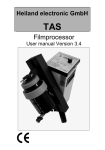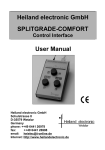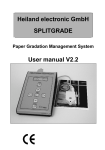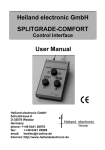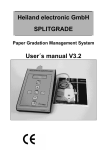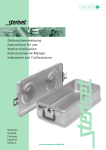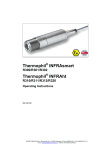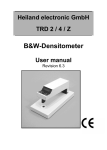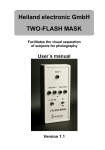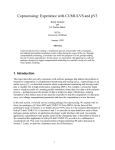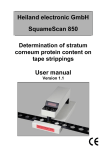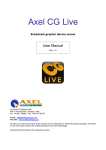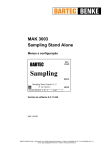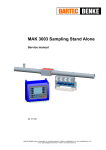Download User manual - ARS
Transcript
Heiland electronic GmbH TD / TD1 / TD2 B&W-Densitometers USERS MANUAL Version 5 2 Table of Contents 1. GENERAL INFORMATION........................................................... 4 2. SAFETY REGULATIONS ............................................................. 5 3. AREA OF APPLICATIONS........................................................... 5 4. INSTRUMENT DESCRIPTION...................................................... 6 5. INSTALLATION ............................................................................ 9 6. READING.................................................................................... 10 7. CARE OF INSTRUMENT ............................................................ 12 8. CALIBRATION CHECK .............................................................. 12 9. GUARANTEE ............................................................................. 13 10. TECHNICAL DATA................................................................... 14 TD / TD1 / TD2 USERS MANUAL Ver.5 3 1. General information Dear Customer, thank you for purchasing a Heiland densitometer. In order to become familiar with the operation of your instrument, please read these instructions carefully and completely before your first use. Packing The packaging of the instrument is shock-absorbent and should be kept for the case of further shipping. Shipment Use only the original packaging for transportation and shipment. First lay the cardboard on the surface of the base unit, then place the plastic block between measuring head and the cardboard. Finally put the instrument inside the plastic bag. Put the calibration strip in the users manual and the users manual on the bottom of the shipment-box, then place the folded cardboard on the right side and the densitometer on the left side of the box. Put the cable into the folded cardboard . 4 2. Safety regulations § § § § Assure that the main voltage and the frequency on the power supply unit is the same as the one indicated on the identification label of the power supply unit. It is not permitted to exchange the power supply against another one without the permission of the manufacturer. Always keep the instrument and the power supply in a dry place and never immerse it in any kind of liquid. To prevent electric shock do not open, neither the densitometer nor the power supply. There are no user serviceable parts inside. 3. Area of applications § § These densitometers are designed for the transmission measurement of films, like B&W films for photographic applications, X-Ray films and microfilms. The reading is taken in units of logarithmic density (log.D) Application of this instrument in other fields is not allowed without our written permission. The following applications are given as a brief introduction how to get benefits of density measurement. - Finding the right combination of film and developer. - Determination of true film sensitivity. - Determination of contrast. - Comparing diazo origin and copy TD / TD1 / TD2 USERS MANUAL Ver.5 5 4. Instrument description Figure 1, Components of the densitometer Zero or Min. button Measuring head Mode LED’s & Display Probe Aperture Base unit TD1 Changeable apertures 6 TD2 Changeable probes § The id-label is located on the bottom of the base unit. § The case of the base unit contains the transmission lamp. The light is emitted through an opal diffuser. § The top of the base unit serves as a platform, on which the film rests during measurement. § The measuring head is mounted to the base unit by a precise bearing. The integrated spring pushes the measuring head in the upper position. The head contains the sensing electronic, below of it the probe is mounted. § The transmission lamp and the displays are activated when the measuring head is lowered. § The 3-digit display allows a precise reading down to 0.01 log.D. § If the minimum sensitivity of the system is reached or if the measuring head is depressed to fast, the display will flash ‘-888’. § If an error occurs during measurement, it will be displayed in the following way: E XX where XX is the number of the error. The only error that can be serviced by the user, is 'E 01' i.e. there is to much light at the probe. This will occur if the aperture (TD1) or the probe (TD2) is removed . In this case simply install the aperture or the probe and measure again. In all other cases please consult the manufacturer. § The LED's beside the 3-digit display show the selected measurement mode while the measuring arm is lowered. T: Transmission measurement D: Density values are displayed § The 'MIN' switch resets the density display to value 0.00, it is only active, while the measuring head is lowered (display is on). All other switches have no functions, except on special versions. TD / TD1 / TD2 USERS MANUAL Ver.5 7 TD The TD densitometer has a fixed aperture mounted inside the none exchangeable probe. The diameter of the aperture is according to the order. TD 1 This instrument is equipped with a set of 4 changeable apertures with diameters of 0,5/1/2/3mm. Smaller diameters reduce the amount of light, thus the max. density is lowered. The aperture is changed by pressing slightly on the edge of the aperture e.g. with the fingernail. Please take care that the aperture directs upside while inserting. After changing the aperture, the density display has to be reset to 0.00 log.D. TD 2 This instrument is equipped with changeable probes. The type MK1 is used for silver and neutral colour films and the type MK2 for Diazo films (UV measurement). For exchanging the probe, grip the probe with two fingers and turn it clock wise or in the right direction (facing it from above). After 3 turns, it can be released. Attention: Don't press the measuring head down without a mounted probe. Otherwise you may damage the spring (bearing). Place the other probe in the hole inside the base of the measuring head and secure that the axial direction of the probe is in a right angle to the base of the measuring head. Turn the probe counter clock wise or in the left direction (facing it from above). After some turns, it is fastened. Use no tools for fastening. After changing the probe, the density display has to be reset to 0.00 log.D. Option 03: PC port At the back side of the base unit is an USB connector located. A suited cable to connect the densitometer to a PC is delivered with this option. See appendix for details. 8 5. Installation 5.1 Location conditions. § Store and use this instrument only in rooms with a temperature from 17°C to 27°C (degree Celsius) and relative humidity from 0 to 70 percent. Fast temperature variations may cause condensation inside the densitometer. Wait at least 30 minutes after moving the instrument from cold to warm environment (more than 10°C temperature difference) § Keep the densitometer away from these environment: - Direct Sunlight - Instruments that emit heat - Aggressive chemicals or liquids - Strong magnetic fields, e.g. from transformers, voltage stabilisers or loud speakers - Electronic devices that emit strong interference like dimmers 5.2 Switching on. § Assure that the main voltage of the power supply unit is the same as the one indicated on the identification label of this unit. § Connect the power supply first to the densitometer and then into the wall plug § The instrument switches on automatically in a stand by mode. Wait at least 2 minutes before taking the first reading. TD / TD1 / TD2 USERS MANUAL Ver.5 9 6. Reading 6.1 General instructions. § Caution: Always depress the measuring head softly until it stops on the film to be measured. § To prevent damage of the precise bearing, always let the measuring head return slowly to the "up" position! Never try to raise it higher than this stop position! § On a digital display, the actual value may intermit between two values. The display changing back and forth between two values should not be a cause for concern. 6.2 Instructions to avoid incorrect reading. § Especially when measuring high densities the subject must be free from dust, lint, finger prints, and other contaminants. § Thick glass plates or filters should be read in low ambient light because of their light conducting tendency. § Films should be placed on the reading area with the emulsion side down. 6.3 Instructions for reset to zero. § Reset the display before starting a series of density measurements. If the part of the subject used for zeroing does not have the lowest density, a negative sign will appear while measuring lower density. § Since in photographic applications density is measured above the base fog, zeroing should always be done on the base fog. That is an unexposed, but a developed area of film. 10 § For other applications, the free light-flux can be used for zeroing, this is equivalent to absolute-zero. If for the measurement of thick glass plates or filters zeroing to the free light flux is required, then the subject to be read must be placed on the surface of the filter or glass plate, so that the light source is not covered up, but the probe rests on the plate when the measuring head is depressed. I.e. the probe must always have the same height, while setting the zero density and while measuring. 6.4 Density measurement. § After zeroing the display, measurement is done by slightly lowering the measuring head until light comes on, then centre the area to be read over the light source and reading the value with the fully depressed measuring head. TD / TD1 / TD2 USERS MANUAL Ver.5 11 7. Care of instrument § The housing and especially the reading area should only be cleaned with a lightly dampened soft cloth or chamois, if necessary with the addition of a mild cleaner § Do not use solvents or abrasive materials. § The measuring head and probe should only be cleaned from dust with a soft brush or compressed air. § Unplug the power supply when not in use for long time periods. § For necessary repairs send the densitometer and the power supply unit to manufacturer or authorised service centre. Any unauthorised opening, will invalidate your guarantee. § CAUTION: To prevent an electric shock do not open the power supply! There are no user serviceable parts inside! 8. Calibration check The instrument is calibrated at the factory. Certification is shipped with the instrument in the form of a transmission calibration strip on which the density values of the calibration are recorded. If the fields are only numbered 1,2,3,4 please refer to the attached calibration list. Note: The densitometer and the calibration strip shipped with it belong together. Since measuring geometry may defer, the calibration strip should not be used to check other densitometers. The calibration strip is made of photographic material. It should be kept in a dark, cool, dry, and dust-free place to protect density values. Do not touch reading area with bare hands. Soiled reading areas cause incorrect readings, especially on high densities. 12 Checking the calibration should be done under the following conditions: § Ambient temperature 20° to 22° Celsius. § Relative humidity between 0 and 70 % § Voltage and frequency must be in tolerance to the one indicated on the identification label of the power supply. § The instrument should be acclimated to ambient conditions and have been connected to the power source for a minimum of 5 minutes before calibrating. § Use aperture with 3mm diameter (TD1 only). § Position the calibration strip so, that the left field (0,00) of it is centred over the light source. Reset the display to zero. § Reading of densities is done in the centre of each test area. If a slight drifting of values is encountered, the values should be averaged. § The tolerance is ±0.02 log. D. If greater variations are encountered, the densitometer and the calibration strip should be sent to the manufacturer or authorised service centre, since a new calibration is not possible without the necessary testing devices. 9. Guarantee This instrument is fully guaranteed for the period of two years from date of purchase. Proof of purchase is the invoice or receipt. Damages due to improper handling or unauthorised access are excluded. This instrument has been carefully manufactured and tested using defect free materials and state-of-the-art technology. In case of a failure the instrument should be returned free of charge to the manufacturer or authorised service centre accompanied by proof of purchase. For the warranted period, the manufacturer will pay cost of replacement parts and repair. However, the manufacturer reserves the right to exchange the instrument. Important: Both the instrument and calibration strip must be send back together! TD / TD1 / TD2 USERS MANUAL Ver.5 13 10. Technical data § § § Dimensions length x width x height Weight Voltage requirements § § Power consumption Aperture diameter § Reading geometry standard Diazo UV probe of TD2 : diffuse/directed : directed/directed Maximum subject size Width x Height : 260 mm x 2 mm Maximum measurable density TD and TD1 aperture Æ3,0mm Æ2,0mm Æ1,0mm Æ 0,5mm TD2 Reading variation Repeat accuracy Temperature range Relative humidity Accessories : 4,0 D : 3,5 D : 3,0 D : 2,0 D : 2,5 D : ±(1% + 0,02 log.D.) : ± 0,01 D : 17 ... 27 °C : 0 ... 70 % : one calibration strip § § § § § § § 14 : 200 x 100 x 100 mm : 1 kg : 12 V DC by use of a wall plug power supply : 3 VA : 0,5/1/2/3 mm according to the order Appendix: Communication parameters Appendix: Communication parameters § Communication port type: USB 2, emulating a serial com port with 9600 Baud, 8 Databit, 2 Stopbit. § The measurement value is transmitted automatically by the instrument every time there is a stable value for about 1 second. Following syntax is used: Character-No. possible Char. meaning 1 T/0 Mode Transmission/StandBy 2 +/Sign 3 0...9/. Value MSB 4 0...9/. Value 5 0...9/. Value 6 0...9/. Value LSB 7 D/% Unit Density or Percentage of dot area 8 CR End of string § Examples: T+1.53D Transmission density: +1.53 log D 0+....D Stand By Issue date: December 2004 Technical data may change without notice. TD / TD1 / TD2 USERS MANUAL Ver.5 15 Heiland electronic GmbH Schulstraße 8 D-35579 Wetzlar Telefon: ++49 6441 26978 Fax: ++49 6441 26988 email: Internet: [email protected] http://www.heilandelectronic.de
















